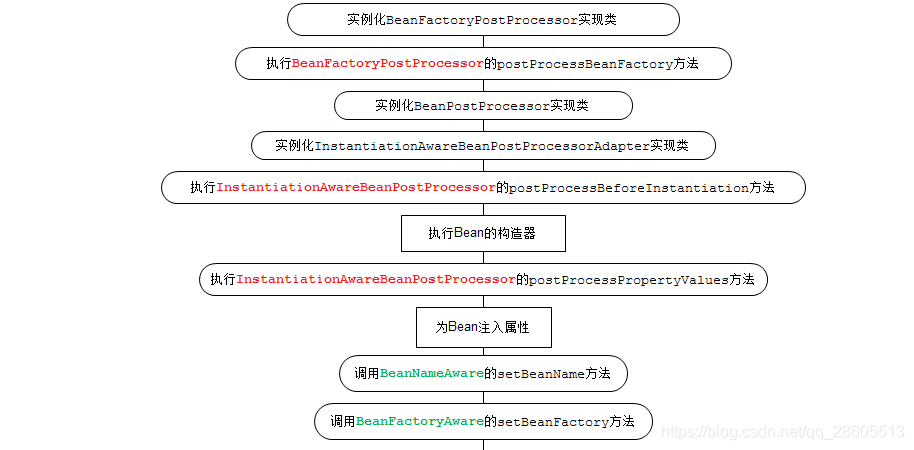Bean的完整生命周期 图序
Bean的完整生命周期如下图:


如果容器注册了上述接口,就会按如上顺序执行。
今天先来看Bean级别的接口
BeanFactoryAware、BeanNameAware
BeanFactoryAware:
public interface BeanFactoryAware extends Aware {
void setBeanFactory(BeanFactory var1) throws BeansException;
}
用于在Bean注入时使Bean感知加载Bean的BeanFactory,可以在该Bean中通过BeanFactory做一些操作,比如获取其他Bean。
BeanNameAware
public interface BeanNameAware extends Aware {
void setBeanName(String var1);
}
用于在Bean注入时使Bean得到在容器中的名字。
使用案例:
public class Test implements BeanNameAware,BeanFactoryAware {
@Override
public void setBeanName(String s) {
System.out.println("获取BeanName = "+s);
}
@Override
public void setBeanFactory(BeanFactory beanFactory) throws BeansException {
System.out.println("获取BeanFactory = "+beanFactory);
}
}
spring的配置文件中配置:
<bean class="com.raycloud.dmj.data.utils.Test"/>
main方法执行:
ApplicationContext context = new ClassPathXmlApplicationContext("bean.xml");
输出结果:
获取BeanName = com.raycloud.dmj.data.utils.Test#0
获取BeanFactory = org.springframework.beans.factory.support.DefaultListableBeanFactory@12cb1b59: defining beans [com.raycloud.dmj.data.utils.Test#0]; root of factory hierarchy
这个BeanFactory在这里就是ApplicationContext的父工厂DefaultListableBeanFactory。
InitializingBean和DisposableBean
InitializingBean:
public interface InitializingBean {
void afterPropertiesSet() throws Exception;
}
在IOC容器为Bean的属性设置完成后执行。
DisposableBean:
public interface DisposableBean {
void destroy() throws Exception;
}
在Bean销毁时执行
使用案例:
public class Test implements InitializingBean,DisposableBean {
private String name;
public String getName() {
return name;
}
public void setName(String name) {
System.out.println("设置name");
this.name = name;
}
@Override
public void destroy() throws Exception {
System.out.println("destroy");
}
@Override
public void afterPropertiesSet() throws Exception {
System.out.println("afterPropertiesSet");
}
}
spring的配置:
<bean class="com.raycloud.dmj.data.utils.Test">
<property name="name" value="ycf"/>
</bean>
main方法执行
ApplicationContext context = new ClassPathXmlApplicationContext("bean.xml");
得到结果:
设置name
afterPropertiesSet
main方法执行
ApplicationContext context = new ClassPathXmlApplicationContext("bean.xml");
((ClassPathXmlApplicationContext) context).close();
得到结果:
设置name
afterPropertiesSet
destroy
<bean>的init-method和destroy-method
除了上面通过两个接口来实现Bean初始化和销毁的操作,
还有通过自定义的初始化和销毁方法来实现,注意通过接口实现和通过自定义的实现两者是共存的,且 InitializingBean的afterPropertiesSet先于 bean标签的init-method[或者注解PostConstruct] 执行,DisposableBean的detory先于bean标签的destory-method[或者注解PreDestroy].
public class Test implements InitializingBean,DisposableBean {
private String name;
public String getName() {
return name;
}
public void setName(String name) {
System.out.println("设置name");
this.name = name;
}
@Override
public void destroy() throws Exception {
System.out.println("destroy");
}
@Override
public void afterPropertiesSet() throws Exception {
System.out.println("afterPropertiesSet");
}
public void initMethod(){
System.out.println("自定义init");
}
public void destoryMethod(){
System.out.println("自定义destory");
}
}
spring配置:
<bean class="com.raycloud.dmj.data.utils.Test" init-method="initMethod" destroy-method="destoryMethod">
<property name="name" value="ycf"/>
</bean>
main执行:
ApplicationContext context = new ClassPathXmlApplicationContext("bean.xml");
((ClassPathXmlApplicationContext) context).close();
得到结果:
设置name
afterPropertiesSet
自定义init
destroy
自定义destory
源码分析
初始化
注意以上的初始化接口,都是在Bean初始化完毕,并且属性设置完毕后才会执行的,它的入口在doCreateBean中
//设置属性
populateBean(beanName, mbd, instanceWrapper);
//初始化Bean
exposedObject = initializeBean(beanName, exposedObject, mbd);
因此对Bean的初始化,我们需要着重关注initializeBean
protected Object initializeBean(final String beanName, final Object bean, @Nullable RootBeanDefinition mbd) {
if (System.getSecurityManager() != null) {
AccessController.doPrivileged((PrivilegedAction<Object>) () -> {
invokeAwareMethods(beanName, bean);
return null;
}, getAccessControlContext());
}
else {
//执行Aware接口的方法
invokeAwareMethods(beanName, bean);
}
Object wrappedBean = bean;
//Bean的后置处理器在执行初始化前,做一些处理。
不是今天 的重点
if (mbd == null || !mbd.isSynthetic()) {
wrappedBean = applyBeanPostProcessorsBeforeInitialization(wrappedBean, beanName);
}
try {
//执行初始化方法
invokeInitMethods(beanName, wrappedBean, mbd);
}
catch (Throwable ex) {
throw new BeanCreationException(
(mbd != null ? mbd.getResourceDescription() : null),
beanName, "Invocation of init method failed", ex);
}
if (mbd == null || !mbd.isSynthetic()) {
//Bean的后置处理器,在初始化后做一些操作
wrappedBean = applyBeanPostProcessorsAfterInitialization(wrappedBean, beanName);
}
return wrappedBean;
}
invokeAwareMethods:
这个方法很简单,就是去回调接口的方法
private void invokeAwareMethods(final String beanName, final Object bean) {
if (bean instanceof Aware) {
if (bean instanceof BeanNameAware) {
((BeanNameAware) bean).setBeanName(beanName);
}
if (bean instanceof BeanClassLoaderAware) {
ClassLoader bcl = getBeanClassLoader();
if (bcl != null) {
((BeanClassLoaderAware) bean).setBeanClassLoader(bcl);
}
}
if (bean instanceof BeanFactoryAware) {
((BeanFactoryAware) bean).setBeanFactory(AbstractAutowireCapableBeanFactory.this);
}
}
}
invokeInitMethods:
protected void invokeInitMethods(String beanName, final Object bean, @Nullable RootBeanDefinition mbd)
throws Throwable {
boolean isInitializingBean = (bean instanceof InitializingBean);
if (isInitializingBean && (mbd == null || !mbd.isExternallyManagedInitMethod("afterPropertiesSet"))) {
if (logger.isTraceEnabled()) {
logger.trace("Invoking afterPropertiesSet() on bean with name '" + beanName + "'");
}
if (System.getSecurityManager() != null) {
try {
AccessController.doPrivileged((PrivilegedExceptionAction<Object>) () -> {
((InitializingBean) bean).afterPropertiesSet();
return null;
}, getAccessControlContext());
}
catch (PrivilegedActionException pae) {
throw pae.getException();
}
}
else {
//执行InitializingBean的afterPropertiesSet
((InitializingBean) bean).afterPropertiesSet();
}
}
if (mbd != null && bean.getClass() != NullBean.class) {
String initMethodName = mbd.getInitMethodName();
if (StringUtils.hasLength(initMethodName) &&
!(isInitializingBean && "afterPropertiesSet".equals(initMethodName)) &&
!mbd.isExternallyManagedInitMethod(initMethodName)) { //执行自定义初始化方法
invokeCustomInitMethod(beanName, bean, mbd);
}
}
}
如上初始化的过程,先执行Aware的接口,使Bean感知到容器、Bean名称甚至类加载器。
然后执行初始化,先执行InitializingBean的afterPropertiesSet,在执行自定义的初始化方法。
至于初始化前后的BeanPostProcessor并不属于Bean的生命周期,而是属于容器的,因此不再一起去讲。
销毁
销毁时在容器销毁的时候才会去销毁Bean,并且需要注意的是只有单例Bean才需要销毁,如果是原型类型的,本身就不由spring容器缓存,就不可能去销毁。
容器的destory方法最终调用到DisposableBeanAdapter的destroy
public void destroy() {
if (!CollectionUtils.isEmpty(this.beanPostProcessors)) {
for (DestructionAwareBeanPostProcessor processor : this.beanPostProcessors) {
processor.postProcessBeforeDestruction(this.bean, this.beanName);
}
}
if (this.invokeDisposableBean) {
if (logger.isTraceEnabled()) {
logger.trace("Invoking destroy() on bean with name '" + this.beanName + "'");
}
try {
if (System.getSecurityManager() != null) {
AccessController.doPrivileged((PrivilegedExceptionAction<Object>) () -> { //执行DisposableBean的destory
((DisposableBean) this.bean).destroy();
return null;
}, this.acc);
}
else {
((DisposableBean) this.bean).destroy();
}
}
catch (Throwable ex) {
String msg = "Invocation of destroy method failed on bean with name '" + this.beanName + "'";
if (logger.isDebugEnabled()) {
logger.info(msg, ex);
}
else {
logger.info(msg + ": " + ex);
}
}
}
//执行自定义的销毁方法
if (this.destroyMethod != null) {
invokeCustomDestroyMethod(this.destroyMethod);
}
else if (this.destroyMethodName != null) {
Method methodToCall = determineDestroyMethod(this.destroyMethodName);
if (methodToCall != null) {
invokeCustomDestroyMethod(methodToCall);
}
}
}
如上也看得到销毁Bean的过程确实是先执行DisposableBean的destory,在执行自定义的销毁方法。